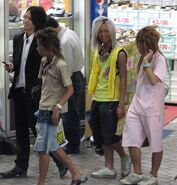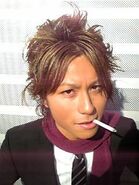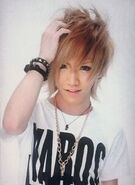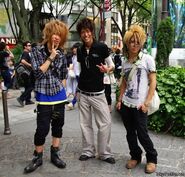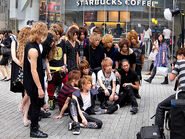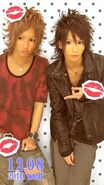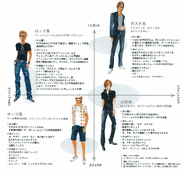Gyaruo is the male version of Gyaru fashion. Like gyaru, the style was bold and became associated with rebellious youth. It was popular in Shibuya 109 during its height. [1][2]
The Name[]
The name gyaruo (ギャル男, ギャルオ, ギャル汚) is simply gyaru (a version of the word "girl" in Japanese) with "o," one reading of the kanji for "male" (男). The name reflects the male version of the normally girly style. [1]
Style Basics[]
In general, gyaruo is meant to be a more sexy take on gyaru fashion. It was often worn by older individuals than those who wore gyaru, and is sometimes also worn by host club hosts. [2]
Hairstyles and Makeup[]
Gyaruo is known for its deep tans and dyed hair, usually in brown and teased in a voluminous style. [1][3] Blond hair is also sometimes seen in some substyles.
Clothing[]
Gyaruo clothing varies depending on its style, but common aspects include tight-fitting clothing, black color schemes, animal prints, and biker boots. [3]
Accessories[]
Gyaruo accessories include layering up with many different types of accessories, including belts, sunglasses, bracelets, and more.[3]
Lifestyle[]
Like gyaru, gyaruo is associated with materialism and a love for para-para and other dance music, as well as rebellion.[1][2]
Substyles[]
Like gyaru, gyaruo saw a number of substyles. [1][3] Some sources categorize these types under larger type umbrellas of Natural, Street, and Older Brother. [2]
- Adult
- American Casual
- Biker
- Center (the male version of Romanba)
- Derika
- Kanji
- Military
- Onii Kei
- Rock
- Salon Kei
- Surfer
- Worker
Magazines[]
A few magazines featured or catered to gyaruo style. [1][3][4]
- Men's Egg
- Men's Egg Bitter
- Men's Digger
- Men's Knuckle
- Men's Roses
- Men's Tiger
- Shibuya Style
- Wolf Ash
Gallery[]
Reference[]
- ↑ 1.0 1.1 1.2 1.3 1.4 1.5 "Gyaruo." Wikipedia. May 6, 2020. Retrieved October 18, 2020 from https://en.wikipedia.org/wiki/Gyaruo
- ↑ 2.0 2.1 2.2 2.3 Gyaruo Fashion Guide. IFS. 2008. Retrieved October 18, 2020 from https://www.ifs.co.jp/knowledge/ta200804/
- ↑ 3.0 3.1 3.2 3.3 3.4 "Gyaruo (Translated Title)." Wikipedia. September 9, 2020. Retrieved October 18, 2020 from https://ja.wikipedia.org/wiki/%E3%82%AE%E3%83%A3%E3%83%AB%E7%94%B7
- ↑ "The Origin of Chara Men's Culture and Men's Egg Night." Rooftop. January 13, 2020. Retrieved October 18, 2020 from https://rooftop.cc/news/2020/01/13220000.php
For further reading please see:
- Yukihide's Blog
- Gyaruo - Gyaru Wikia
- Gyaruo - Gyaru Wiki

